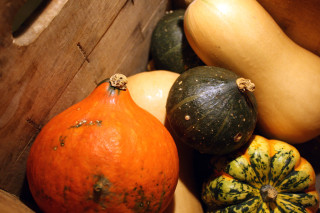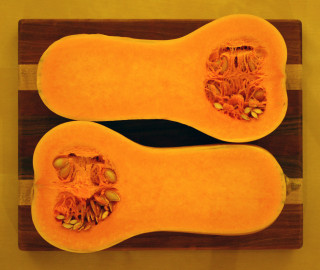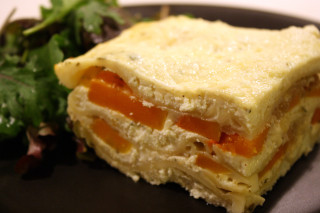Warning: Trying to access array offset on value of type null in /home/devonkarn/rootsnveggies.com/wp-content/themes/herothemetrust/functions.php on line 819
Rockville Market Farm: A winter squash wonderland

This article originally appeared in the winter 2009 issue of Edible Green Mountain magazine.
Winter squash is a demure vegetable whose lure isn’t as bawdy as a screaming red tomato or as fragile as the crisp spring pea. Their hard skins in dark, pine needle green, sunset crimson, and striated gold protect squash’s treasured flesh from spoilage through the winter months and hide something delicious. Once a sharp knife coaxes open these ancient-looking, knobby packages, the possibilities are endless—roasted with butter and maple; simmered in a spicy curry over rice; smashed and used like pumpkin in sweet treats; cubed in a hearty, herb-infused stew. Their antioxidant-rich flesh is saturated with vitamins and fiber, making squash a rare blend of healthy, sweet and filling all at once.
 If anyone has cozied up to the beauty and versatility of winter squash, it’s the people behind the Rockville Market Farm, a certified organic vegetable farm in the hills of Starksboro. Eric and Keenann Rozendaal grow about ten different kinds of these pumpkin cousins for sale as whole squash and packages of prepared butternut. Varieties range from yellow-fleshed acorn and its painted cousin carnival, to dark green buttercup with its deep, nutty and nearly stringless insides, to the vibrant red kuri, whose tangerine flesh has a slight vegetal favor reminiscent of summer squash. Nearly 80 percent of Rockville’s squash crop is the smooth, tan-skinned butternut.
If anyone has cozied up to the beauty and versatility of winter squash, it’s the people behind the Rockville Market Farm, a certified organic vegetable farm in the hills of Starksboro. Eric and Keenann Rozendaal grow about ten different kinds of these pumpkin cousins for sale as whole squash and packages of prepared butternut. Varieties range from yellow-fleshed acorn and its painted cousin carnival, to dark green buttercup with its deep, nutty and nearly stringless insides, to the vibrant red kuri, whose tangerine flesh has a slight vegetal favor reminiscent of summer squash. Nearly 80 percent of Rockville’s squash crop is the smooth, tan-skinned butternut.
While winter squash may seem like an odd choice for a farm to hang its hat on, the notion is full of practicality for this piece of land. The farm’s sloping, tree-framed fields are rocky as heck, but most squash varieties don’t really mind that infraction; where a carrot will corkscrew grotesquely around the smallest pebble, squash are thankful for the good drainage and will happily snake their roots through the gravelly loam and stretch their vines across Rockville’s ample acreage. Then there are the economic advantages—few other farms around the state have developed the infrastructure to support a dedicated winter squash operation, so filling the niche with a crop that can generate income through the winter while other vegetable fields lie dormant just makes sense.
The Rozendaals plant 12 to 15 acres of winter squash intensively on raised beds covered with black plastic, eliminating the need for irrigation or heavy weeding. All of the plants are started from seed in mid-May and allowed to grow for two weeks in the warm, natural light of the farm’s greenhouses. Transplanting rather than starting squash from seed lets the farmers get a jump on Vermont’s short growing season and helps the vines grow into a more uniform stand. Seeding 62,000 pots by hand is a job that could be daunting, but the Rozendaals have help—local families pitch in for a few days each spring in exchange for plants and produce. And all this individual attention certainly makes for prolific plants.
Rockville Market Farm had such a bumper crop in 2007 that after stashing squash in every building on the farm and piling more into neighbors’ sheds and garages, they still ran out of storage space and had to leave a bounty of produce in the field. This missed opportunity prompted them to build on the property a dedicated storage barn capable of housing a whopping 5,000 bushels. Hard-skinned winter squash doesn’t need refrigeration; instead, its optimal storage temperature hovers around 50 degrees. The new, well-insulated metal structure keeps huge, wooden 20-bushel crates of squash cool, dark, and open to circulating air. In these conditions, squash harvested in October can be stored until Easter without losing their signature flavor and texture.
 Along one edge of the storage barn, a handful of men prepare roughly a third of Rockville’s butternut crop for the farm’s ready-to-cook offerings each fall. Each squash is peeled on a lathe-like spindle that removes the skin in one long, thin shoelace string, then handed down the line. The next worker lops off the top and bottom of the squash with a large, hinged knife that resembles a paper cutter. The third guy scoops out the seeds by hand with a metal, paddle-shaped spoon, and passes it to his neighbor to be sliced. Some cut in half, collected into big, clear 25-pound bags and delivered directly to local restaurants and cafes, where they might become a warm, savory dish in the hot buffets at Hunger Mountain, City Market, Healthy Living or Stone Soup. The rest are cut into vibrant orange strips and laid sideways on a small conveyer belt that takes them through a sharp line of parallel blades, slicing the strips into even cubes. The fully prepared chunks are shrink wrapped into 20-ounce packages and sold at most co-ops around the state. They’re a convenient option for those who lack food prep time or the strength to cleave open a hard, stubborn squash.
Along one edge of the storage barn, a handful of men prepare roughly a third of Rockville’s butternut crop for the farm’s ready-to-cook offerings each fall. Each squash is peeled on a lathe-like spindle that removes the skin in one long, thin shoelace string, then handed down the line. The next worker lops off the top and bottom of the squash with a large, hinged knife that resembles a paper cutter. The third guy scoops out the seeds by hand with a metal, paddle-shaped spoon, and passes it to his neighbor to be sliced. Some cut in half, collected into big, clear 25-pound bags and delivered directly to local restaurants and cafes, where they might become a warm, savory dish in the hot buffets at Hunger Mountain, City Market, Healthy Living or Stone Soup. The rest are cut into vibrant orange strips and laid sideways on a small conveyer belt that takes them through a sharp line of parallel blades, slicing the strips into even cubes. The fully prepared chunks are shrink wrapped into 20-ounce packages and sold at most co-ops around the state. They’re a convenient option for those who lack food prep time or the strength to cleave open a hard, stubborn squash.
The squash share the farm with other crops including bright sunflowers, greenhouse plants and a cornucopia of vegetables, plus broiler chickens and pasture-raised pigs, both of which are sold in shares directly from the farm. In the coming year, Eric hopes to bring the squash and pork sides of the farm closer together. Rockville’s happy, pink pigs already enjoy rooting around in fruit and vegetable scraps from the farm’s produce operations, but soon they’ll be finished on a diet of butternut squash seeds scooped from their fresh orange pulp as the squash is processed for market. Just as the Spanish finish their pigs on acorns and farmers in the South fatten theirs on peanuts, Rockville’s drove of pigs will be fed the nutty, oval butternut seeds before slaughter to produce richer, more flavorful meat. (The seeds also make an overlooked yet flavorful snack for humans, too; simply rinse, season, and roast as you would pumpkin seeds.)
As squash farmers, the Rozendaals eat plenty of it. Eric’s favorite way to enjoy squash, hands down, is cubed and roasted with root vegetables alongside one of the farm’s chickens so the vegetables caramelize in the savory drippings. A close second would be bowl of sweet, velvety butternut bisque. He speaks the truth when he explains that there’s nothing quite like squash to warm the belly through a Vermont winter.
Recipes
Butternut Squash and Caramelized Onion Lasagna
 Cheesy, gooey and satisfying, this wintery take on lasagna stars butternut squash, sage, and thyme in the roles traditionally played by tomato, oregano, and basil. Serves 8 to 10.
Cheesy, gooey and satisfying, this wintery take on lasagna stars butternut squash, sage, and thyme in the roles traditionally played by tomato, oregano, and basil. Serves 8 to 10.
1 pound lasagna noodles
2 tablespoons butter
2 tablespoons olive oil
1 teaspoon sugar
3 large sweet onions, sliced into ¼-inch rings
2 pounds butternut squash, peeled, seeded cut into ¼-inch slices
1 (14-ounce) can vegetable broth
3 tablespoons chopped fresh thyme
2 tablespoons chopped fresh sage
2 (15-ounce) containers whole-milk ricotta cheese
4 cups grated mozzarella cheese
2 cups grated mixed Parmesan and Romano cheeses
Salt and black pepper
3 large eggs
Cook the pasta until al dente; drain and rinse with cold water to prevent sticking. Set aside.
Melt the butter with the olive oil in a large skillet over medium heat. Stir in the sugar and onions and sauté for 20 minutes, until the onions are soft and beginning to turn golden. Transfer to a bowl and return the skillet to the stovetop.
Add the squash, broth, 1 tablespoon of the thyme, and 1 tablespoon of the sage to the skillet. Cover and simmer over medium heat until the squash is just tender, about 6 minutes. Uncover and cook until the squash is very soft but still retains its shape, 7 to 10 minutes. Drain, reserving the cooking liquid for another use.
Stir together the ricotta, 2 cups of the mozzarella cheese, 1½ cups of the Parmesan cheese mixture and the remaining 2 tablespoons thyme and 1 tablespoon sage in a large bowl. Season to taste with salt and pepper. Mix in the eggs.
Preheat the oven to 350°F. Oil a 9- by 13-inch glass or ceramic baking dish.
Spread 1½ cups of the ricotta mixture over the bottom of the baking dish. Arrange three noodles on top. Spread 2 cups of the ricotta mixture over noodles. Arrange half of the squash slices over. Sprinkle with half the onions and 1 cup of the mozzarella. Top with three noodles, then 2 cups ricotta mixture, the remaining squash, remaining onions, and remaining 1 cup mozzarella. Finish with a layer of three noodles, then the remaining 2 cups ricotta mixture. Sprinkle with the remaining Parmesan mixture. Cover with oiled aluminum foil.
Bake for 35 minutes. Uncover; bake until heated through, about 30 minutes longer, until top begins to brown. Let stand 10 minutes before serving. (The lasagna can be assembled one day ahead and refrigerated).
Spiced Squash Cookies
These spiced cookies have a light, cake-like texture that’s welcoming on a cold afternoon. Makes 5½ dozen.
 ½ cup butter, at room temperature
½ cup butter, at room temperature
¾ cup white sugar
¾ cup firmly packed packed brown sugar
2 large eggs
1½ cups mashed, cooked butternut squash
2½ cups all-purpose flour
1 teaspoon baking soda
2½ teaspoons baking powder
½ teaspoon salt
2 teaspoons ground cinnamon
½ teaspoon ground nutmeg
¼ teaspoon ground ginger
1 cup raisins
1½ cups chopped pecans
Preheat the oven to 375°F.
In a large mixing bowl, cream together the butter and sugars until fluffy. Beat in the eggs and squash.
In a separate bowl, sift together flour, baking soda, baking powder, salt, cinnamon, nutmeg and ginger. Add to the squash mixture, stirring until well blended. Fold in the raisins and nuts. Drop by rounded teaspoonfuls onto an ungreased cookie sheet, spacing them 2 inches apart.
Bake for 12 to 15 minutes, until the edges begin to turn golden. Remove from oven and let cookies rest on the sheets for 10 minutes then transfer to wire racks to cool.
